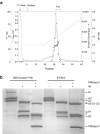Lentiviral vector platform for production of bioengineered recombinant coagulation factor VIII
- PMID: 21081907
- PMCID: PMC3034847
- DOI: 10.1038/mt.2010.239
Lentiviral vector platform for production of bioengineered recombinant coagulation factor VIII
Abstract
Patients with hemophilia A present with spontaneous and sometimes life-threatening bleeding episodes that are treated using blood coagulation factor VIII (fVIII) replacement products. Although effective, these products have limited availability worldwide due to supply limitations and product costs, which stem largely from manufacturing complexity. Current mammalian cell culture manufacturing systems yield around 100 µg/l of recombinant fVIII, with a per cell production rate of 0.05 pg/cell/day, representing 10,000-fold lesser production than is achieved for other similar-sized recombinant proteins (e.g. monoclonal antibodies). Expression of human fVIII is rate limited by inefficient transport through the cellular secretory pathway. Recently, we discovered that the orthologous porcine fVIII possesses two distinct sequence elements that enhance secretory transport efficiency. Herein, we describe the development of a bioengineered fVIII product using a novel lentiviral-driven recombinant protein manufacturing platform. The combined implementation of these technologies yielded production cell lines that biosynthesize in excess of 2.5 mg/l of recombinant fVIII at the rate of 9 pg/cell/day, which is the highest level of recombinant fVIII production reported to date, thereby validating the utility of both technologies.
Figures






Similar articles
-
Generation of an optimized lentiviral vector encoding a high-expression factor VIII transgene for gene therapy of hemophilia A.Gene Ther. 2013 Jun;20(6):607-15. doi: 10.1038/gt.2012.76. Epub 2012 Sep 20. Gene Ther. 2013. PMID: 22996197 Free PMC article.
-
Bioengineering of coagulation factor VIII for improved secretion.Blood. 2004 May 1;103(9):3412-9. doi: 10.1182/blood-2003-10-3591. Epub 2004 Jan 15. Blood. 2004. PMID: 14726380
-
Preclinical Development of a Hematopoietic Stem and Progenitor Cell Bioengineered Factor VIII Lentiviral Vector Gene Therapy for Hemophilia A.Hum Gene Ther. 2018 Oct;29(10):1183-1201. doi: 10.1089/hum.2018.137. Hum Gene Ther. 2018. PMID: 30160169 Free PMC article.
-
Perspectives on progressive strategies and recent trends in the production of recombinant human factor VIII.Int J Biol Macromol. 2018 Nov;119:496-504. doi: 10.1016/j.ijbiomac.2018.07.164. Epub 2018 Jul 29. Int J Biol Macromol. 2018. PMID: 30063930 Review.
-
Expression of factor VIII in recombinant and transgenic systems.Blood Cells Mol Dis. 2002 Mar-Apr;28(2):234-48. doi: 10.1006/bcmd.2002.0508. Blood Cells Mol Dis. 2002. PMID: 12064919 Review.
Cited by
-
Structure of Blood Coagulation Factor VIII in Complex With an Anti-C2 Domain Non-Classical, Pathogenic Antibody Inhibitor.Front Immunol. 2021 Jun 10;12:697602. doi: 10.3389/fimmu.2021.697602. eCollection 2021. Front Immunol. 2021. PMID: 34177966 Free PMC article.
-
Identification of coagulation factor IX variants with enhanced activity through ancestral sequence reconstruction.Blood Adv. 2021 Sep 14;5(17):3333-3343. doi: 10.1182/bloodadvances.2021004742. Blood Adv. 2021. PMID: 34477814 Free PMC article.
-
Transient transfection of serum-free suspension HEK 293 cell culture for efficient production of human rFVIII.BMC Biotechnol. 2011 Nov 24;11:114. doi: 10.1186/1472-6750-11-114. BMC Biotechnol. 2011. PMID: 22115125 Free PMC article.
-
Structure of coagulation factor VIII bound to a patient-derived anti-C1 domain antibody inhibitor.Blood. 2023 Jul 13;142(2):197-201. doi: 10.1182/blood.2023020181. Blood. 2023. PMID: 37192299 Free PMC article.
-
Target-Cell-Directed Bioengineering Approaches for Gene Therapy of Hemophilia A.Mol Ther Methods Clin Dev. 2018 Jan 31;9:57-69. doi: 10.1016/j.omtm.2018.01.004. eCollection 2018 Jun 15. Mol Ther Methods Clin Dev. 2018. PMID: 29552578 Free PMC article.
References
-
- Garber K. rFactor VIII deficit questioned. Nat Biotechnol. 2000;18:1133. - PubMed
-
- Kaufman RJ, Pipe SW, Tagliavacca L, Swaroop M., and, Moussalli M. Biosynthesis, assembly and secretion of coagulation factor VIII. Blood Coagul Fibrinolysis. 1997;8 Suppl 2:S3–14. - PubMed
-
- Swaroop M, Moussalli M, Pipe SW., and, Kaufman RJ. Mutagenesis of a potential immunoglobulin-binding protein-binding site enhances secretion of coagulation factor VIII. J Biol Chem. 1997;272:24121–24124. - PubMed
-
- Miao HZ, Sirachainan N, Palmer L, Kucab P, Cunningham MA, Kaufman RJ, et al. Bioengineering of coagulation factor VIII for improved secretion. Blood. 2004;103:3412–3419. - PubMed
Publication types
MeSH terms
Substances
Grants and funding
LinkOut - more resources
Full Text Sources
Other Literature Sources

